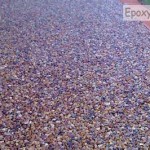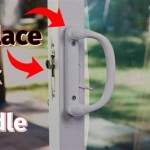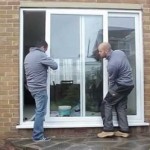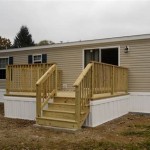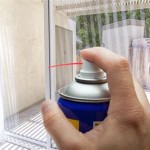Removing Rust Stains From Concrete Patios
Concrete patios, while durable and aesthetically pleasing, are susceptible to various forms of staining, among the most persistent being rust. This unsightly discoloration can originate from a variety of sources, including metal furniture, tools left outdoors, or even fertilizers containing iron. Understanding the nature of rust and the methods for its removal is essential for maintaining the appearance and longevity of a concrete patio.
Rust, chemically known as iron oxide, forms when iron or an iron alloy, such as steel, is exposed to oxygen and moisture. This electrochemical reaction results in the reddish-brown, flaky substance that adheres readily to porous surfaces like concrete. The porous nature of concrete allows rust particles to penetrate below the surface, making simple sweeping or rinsing ineffective for complete removal. Therefore, specialized cleaning techniques and rust-dissolving agents are often necessary to restore the concrete's original appearance.
Ignoring rust stains can lead to further degradation of the concrete. While rust itself doesn't directly corrode concrete, the presence of moisture that facilitates rust formation can contribute to other issues, such as freeze-thaw damage in colder climates. The expanding ice can exert pressure within the concrete's pores, leading to cracking and crumbling over time. Moreover, established rust stains can become increasingly difficult to remove the longer they are left untreated, increasing the likelihood of permanent discoloration.
Identifying the Source of the Rust Stain
Before attempting to remove rust stains, identifying the source is crucial. This will not only help in preventing future staining but also in selecting the most appropriate cleaning method. Common sources include:
- Metal Furniture: Outdoor furniture with metal legs or frames can leave rust stains, especially if the protective coating is chipped or damaged.
- Tools and Equipment: Leaving tools, gardening equipment, or metal objects on the patio after use can lead to rust stains, particularly after rainfall.
- Fertilizers: Some lawn and garden fertilizers contain iron as a nutrient. If these fertilizers are spilled or tracked onto the patio, they can cause rust stains.
- Watering Systems: Sprinkler systems or hoses made with metal components can contribute to rust staining if they leak or are left in contact with the concrete.
- Vehicular Components: Drips or spills of automotive fluids containing iron, or parts falling from vehicles parked on the patio, can cause rust stains.
Once the source has been identified and addressed (e.g., moving metal furniture, repairing leaks), the focus can shift to removing the existing rust stain.
Choosing the Right Rust Removal Method
Several methods can be employed to remove rust stains from concrete patios, each with its own advantages and disadvantages. The choice of method depends on the severity of the stain, the type of concrete, and the user's preference for chemical or non-chemical solutions. It is always recommended to test any cleaning solution in an inconspicuous area of the patio first to ensure it does not damage or discolor the concrete.
1. Chemical Rust Removers: These are typically acidic solutions designed to dissolve rust. Many commercially available rust removers contain oxalic acid, phosphoric acid, or hydrochloric acid. Oxalic acid is often considered a safer option compared to hydrochloric acid, which can be more corrosive. When using any chemical rust remover, it is essential to follow the manufacturer's instructions carefully and wear appropriate protective gear, including gloves, eye protection, and a mask. These chemicals can be hazardous if inhaled or come into contact with skin or eyes.
To use a chemical rust remover effectively, the affected area should be pre-wetted. The rust remover is then applied according to the product's instructions, often involving brushing or scrubbing the solution into the stained area. The solution is typically left to dwell for a specified period, allowing the acid to react with the rust. After the dwell time, the area should be thoroughly rinsed with water to remove the dissolved rust and any remaining chemical residue. Multiple applications may be necessary for stubborn stains.
2. Vinegar and Baking Soda: This is a milder, more environmentally friendly option that utilizes the mild acidity of vinegar and the abrasive qualities of baking soda. White vinegar is generally preferred due to its higher acidity compared to other types of vinegar. The process involves applying vinegar directly to the rust stain and allowing it to sit for several minutes. Baking soda is then sprinkled over the vinegar-soaked area, creating a paste. The paste is scrubbed into the stain using a stiff brush. The mixture is then rinsed away with water. This method is less potent than chemical rust removers and may require multiple applications for significant results.
3. Lemon Juice and Salt: Similar to vinegar and baking soda, lemon juice and salt leverage natural acidity and abrasiveness. Lemon juice, being acidic, can help dissolve rust, while salt acts as a gentle abrasive to scrub away the loosened rust particles. The process involves squeezing lemon juice liberally onto the rust stain and then sprinkling salt over the juice. This mixture is left to sit for a few hours, allowing the lemon juice to penetrate and loosen the rust. The area is then scrubbed with a stiff brush and rinsed thoroughly with water. Like the vinegar and baking soda method, this approach is best suited for lighter rust stains.
4. Commercial Concrete Cleaners: Many commercial concrete cleaners are formulated to remove a variety of stains, including rust. These cleaners often contain detergents and solvents that help to lift and dissolve stains. When using a commercial concrete cleaner, it is essential to choose a product specifically designed for concrete surfaces. The product should be applied according to the manufacturer's instructions, typically involving spraying or pouring the cleaner onto the stain, scrubbing, and rinsing with water. The effectiveness of commercial concrete cleaners varies depending on the specific formulation and the severity of the rust stain.
5. Pressure Washing: While not a rust removal method in itself, pressure washing can be used in conjunction with other cleaning solutions to enhance their effectiveness. A pressure washer uses a high-pressure stream of water to blast away dirt, debris, and loose rust particles. It is important to use caution when pressure washing concrete, as excessive pressure can damage the surface. A wide-angle nozzle should be used, and the pressure should be adjusted to a level that effectively cleans the surface without causing pitting or etching. After applying a rust removal solution, pressure washing can help to remove the loosened rust and cleaning residue more effectively.
Application and Precautions
Regardless of the chosen rust removal method, several important steps should be followed to ensure effectiveness and safety. These steps include:
- Surface Preparation: Before applying any cleaning solution, the concrete patio should be thoroughly cleaned to remove any loose dirt, debris, or organic matter. This can be done by sweeping or rinsing the patio with water.
- Protective Gear: When using chemical rust removers, wear appropriate protective gear, including gloves, eye protection, and a mask. Even with milder solutions like vinegar and baking soda, gloves are recommended to protect the skin.
- Testing: Before applying any cleaning solution to the entire patio, test it in an inconspicuous area to ensure it does not damage or discolor the concrete.
- Application: Apply the cleaning solution according to the manufacturer's instructions or as described in the relevant method. Ensure the solution is evenly distributed over the rust-stained area.
- Dwell Time: Allow the cleaning solution to dwell on the rust stain for the recommended time. This allows the solution to penetrate and dissolve the rust.
- Scrubbing: After the dwell time, scrub the treated area with a stiff brush. This helps to loosen and remove the dissolved rust particles.
- Rinsing: Thoroughly rinse the area with water to remove the dissolved rust and any remaining cleaning residue.
- Neutralization: If using an acidic rust remover, consider neutralizing the area with a mild alkaline solution (e.g., baking soda and water) after rinsing. This helps to prevent any further etching or damage to the concrete.
- Drying: Allow the patio to dry completely before replacing any furniture or using the area.
For particularly stubborn or extensive rust stains, it may be necessary to repeat the cleaning process multiple times or to consult with a professional concrete cleaning service. Professional services have access to specialized equipment and stronger cleaning solutions that can effectively remove even the most challenging rust stains.
Preventing Future Rust Stains
After successfully removing rust stains from a concrete patio, taking steps to prevent future staining is essential. Preventive measures can significantly reduce the likelihood of rust stains recurring and help maintain the patio's appearance long-term.
- Elevate Metal Furniture: Use furniture pads or coasters under the legs of metal furniture to prevent direct contact with the concrete. This reduces the risk of rust stains caused by moisture and oxidation.
- Protect Tools and Equipment: Store tools, gardening equipment, and other metal objects in a shed, garage, or covered area to protect them from the elements. If they must be left outdoors, place them on a protective mat or surface.
- Use Rust-Resistant Materials: When purchasing outdoor furniture or equipment, choose rust-resistant materials such as aluminum, stainless steel, or powder-coated metal.
- Maintain Sprinkler Systems: Regularly inspect sprinkler systems and hoses for leaks and ensure that any metal components are properly maintained and protected from corrosion.
- Seal the Concrete: Applying a concrete sealer can help to protect the patio from stains and moisture damage. Choose a high-quality sealer that is specifically designed for outdoor concrete surfaces.
- Promptly Clean Spills: Immediately clean up any spills of fertilizers, automotive fluids, or other substances that may contain iron or contribute to rust staining.
- Regular Cleaning: Periodically clean the concrete patio with a mild detergent and water to remove dirt, debris, and other contaminants that can contribute to staining.
By implementing these preventative measures and addressing rust stains promptly, the appearance and lifespan of a concrete patio can be significantly prolonged.

How To Remove Rust From Concrete Using Wd 40

How To Remove Rust Stains From Concrete Network

Customer Removes Rust From Sprinkler Stain

How To Remove Rust Stains From Sandstone Patio Concrete Pavers

Iron Out Outdoor Rust Stain Remover Summit Brands

How Do I Use Concrete Rust Remover

How To Remove Old And New Rust Stains From Concrete Lovetoknow

How To Remove A Rust Stain From Concrete Patio Youtube

How To Remove A Rust Stain Off Concrete Or Bluestone

Rust Remover Challenge What Removes Stains Off Concrete Youtube

